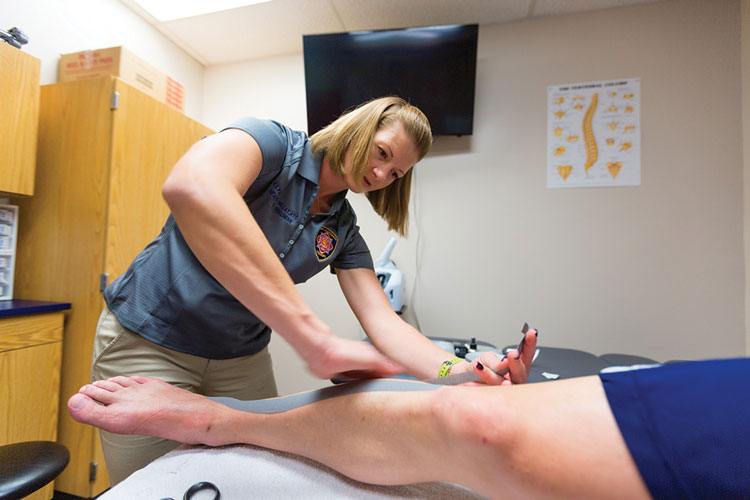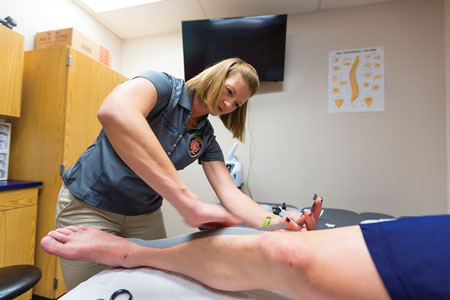
By DEENA KILPATRICK
Health care costs are the largest expense to departmental reserves. Unfortunately, this expense is projected to increase, causing departments to begin exploring other cost-efficient means that will allow personnel to receive quality care.
The introduction of occupational health within the workplace has brought medical providers “in house” by establishing on-site clinics through which employees may receive medical care. You can contact medical providers through a hospital, clinic, or private firm, or they can be employed full time by the organization. Generally, the clinic is open to all employees and will provide physical examinations, health screenings, health and wellness education, and urgent care. Although these measures have increased productivity and decreased absenteeism, work-related injury remains a major concern. This is where an athletic trainer (AT) comes in.
Traditionally, an AT is found in the collegiate and secondary school setting, working with professional sports teams or at sporting events. However, recently, ATs have begun branching out into the industrial, corporate, military, law enforcement, and fire department settings. In this capacity, an AT can reduce the number and severity of workplace injuries that can have a substantial effect on workers’ compensation costs.
Just as athletes experience injuries throughout the course of their athletic participation, firefighters incur athletic-type injuries that may hinder their abilities on the job. Firefighters are considered tactical athletes; the very nature of the job entails long hours, unpredictable situations, and awkward positioning at a moment’s notice without appropriate warmup. Tactical athletes must have the strength, speed, agility, and endurance to complete the mission at hand. Unlike sports arenas, there is no buzzer to indicate that the call is over or it’s time to send in a substitute. Whether through fatigue or injury, a firefighter who is unable to work at 100-percent capacity can jeopardize his own life, the life of another firefighter, or the life of a civilian.1
The American Medical Association has recognized ATs as allied health care providers since the 1990s. ATs are not fitness experts or personal trainers; they are health care professionals who collaborate with physicians. The services provided by ATs include prevention, emergency care, clinical diagnosis, therapeutic intervention, and rehabilitation of injuries and medical conditions. ATs work under the direction of physicians as prescribed by state licensure statutes.2 ATs develop an understanding of the job requirements for public safety personnel and are often employed “on site” to provide for the prevention, care, and rehabilitation of injuries.
ATs have begun working in local and state law enforcement agencies, the Federal Bureau of Investigation’s National Academy Associates training school, and the Federal Law Enforcement Training Centers. The United States Army, Navy, Air Force, and Marine Corps also employ ATs.
The San Antonio (TX) Fire Department (SAFD) is one of the first major metropolitan fire departments to employ an AT. Although this program is still in its infancy, it has demonstrated a significant return on the investment.
Increased Quality of Care
Having an AT on site provides personnel with immediate diagnosis and treatment of injuries, thus expediting the healing time and decreasing the amount of pain experienced post-injury. A fully functioning on-site clinic will allow for various treatment options; those available within the SAFD athletic training room include the following: thermotherapy, cryotherapy, ultrasound, electrical stimulation, cold laser, spinal decompression, prescriptive exercise programs, concussion management, and recommendations for appropriate braces.
Complete biomechanical assessments provide valuable insight into the identification of potential injury risk factors. Rehabilitation of musculoskeletal injuries includes a thorough evaluation of functional and work-related biomechanics. With this information, patients then receive individualized rehabilitation plans designed to correct all deficiencies and weaknesses. This type of preventive program will not only decrease the number of injuries but also lead to a decrease in the severity of injuries.
Collaboration between physicians and ATs provides injured personnel with the necessary support from a team of medical professionals rather than one individual medical professional. An AT may also be an educational resource, providing better understanding of a patient’s injury as well as educating him in the treatment and rehabilitation necessary to return to full duty.
 |
| (1) The author applies kinesiotape to finish a patient’s treatment. (Photo by Albert Pedroza.) |
Reducing Health Care Costs
There is evidence that ATs decrease health care costs and expedite recovery following an injury. In a 2011 study determining the efficacy of an internal employee health program with early, in-house access to physical medicine and rehabilitation provided by ATs, researchers reported a more than 50-percent decrease in lost work days. Additionally, the odds of returning to work within three weeks more than doubled.3 Another study in 1993 documented the cost-effectiveness of hiring ATs in the nontraditional setting. Workers who have suffered the trauma of injury recognize not only the physical benefits of these programs but also the psychological effects. These programs have proven their value in increasing productivity and reducing the spiraling costs of health care.4
Research documents the positive return on investment (ROI) for ATs within the industrial setting. A 2009 National Athletic Trainers’ Association survey of industrial companies that use the services of a certified AT reported a 100-percent positive ROI from having an AT on site. Ninety percent indicated that employee days away from work decreased by 25 percent or more after adding an AT to their health and wellness resources. Almost half of the companies had emergency room costs reduced by 50 percent or more, and more than 50 percent reported a decrease in costs associated with workplace injuries. 5 The initial capital outlay for equipment and facilities, in addition to the AT benefits and salaries, was recovered within six months of operation through cost savings. (4)
These data are further supported by the Fairfax County Police Department Injury Management Program, which was implemented in 2006. Adding an AT to the Fairfax County Criminal Justice Academy reduced overall medical costs by 49.5 percent and musculoskeletal costs by 86.3 percent within the first three years of operation. Recruits received an immediate clinical assessment of conditions; bypassed the emergency room; and, when necessary, were directed straight to the approved physician provider.6
The first nine months that the SAFD athletic training room was in operation resulted in $593,682.59 of cost savings. This amount is likely to grow exponentially as the SAFD learns how to use this new benefit.
Injury prevention is the key to reducing medical costs, resulting in fewer physician visits, decreased lost time days, and a reduction in workers’ compensation claims and payments. Early clinical assessment; access to regular treatment; functional testing prior to returning to duty; and communication among physicians, the AT, and appropriate supervision create a medical support unit for personnel when injuries occur.
The men and women working within this setting are tactical athletes and, as such, experience athletic-type injuries. The very nature of the job requires personnel to engage in high-risk actions that entail speed, strength, agility, and aerobic and anaerobic fitness. These professionals deserve the same medical benefit that professional athletes such as those in the National Football League, National Basketball Association, Major League Baseball, and so on receive.
ATs recognize the physical, mental, and emotional demands as well as job requirements for firefighters. Fire departments that use an AT will demonstrate decreased health care costs and will aid in returning personnel to full duty stronger. Just as diagnosis and preventive maintenance are understood to be necessary to keep fire apparatus in service, they are no less important for the health and safety of each firefighter.7
References
1. Norwood, PJ, Newman, N. “Train like the tactical athlete you are!” Fire Engineering (12/22/2014).
2. National Athletic Trainers’ Association. “Terminology,” http://www.nata.org/athletic-training/terminology. Accessed January 21, 2016.
3. Larson, MC, et al. “Reducing Lost Workdays After Work-related Injuries.” Journal of Occupational and Environmental Medicine 53.10 (2011): 1199-204.
4. Zimmerman, GR. Industrial Medicine and Athletic Training: Cost-Effectiveness in the Non-traditional Setting (1993). Journal of Athletic Training, 28(2), 131-136.
5. National Athletic Trainers’ Association. “Athletic Trainers Provide High Return on Investment in Today’s Workplace.” Accessed January 21, 2016.
6. Burke, NC. “Athletic Trainers: A Fresh Approach to Reducing Medical Costs and Enhancing Safety,” The Police Chief, 82 (May 2015): 26-30.
7. State Fire Marshal’s Office. FY 13 Firefighter Fatality Investigation: Annual Report to the Texas Commissioner of Insurance.
DEENA KILPATRICK MS, LAT, ATC, is the athletic trainer for the San Antonio (TX) Fire Department. She received a bachelor’s degree in athletic training from Texas Lutheran University and a master’s degree in athletic training from West Virginia University. She has athletic training experience working at the Division III, Division I, and secondary school setting as well as working with the U.S. Olympic Fencing Team. Kilpatrick also has an athletic training license for the state of Texas as well as a national certification. She is the vice president of the Public Safety Athletic Trainers’ Society as well as the public safety liaison to the Committee on Practice Advancement for the National Athletic Trainers’ Association.
Acute Coronary Syndromes in Firefighters: An “Athletic ” Approach to Prevention
Firefighter Fitness: So, Now You’re Injured
Letter to the Editor: Firefighter Fitness Should Focus on Injury Prevention
Fire Engineering Archives

